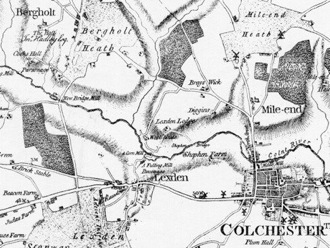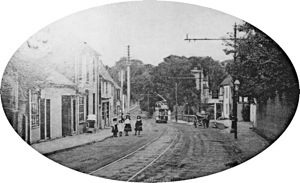Lexden, or Lessenden as it was then known is mentioned in the Doomsday Book of 1086. It was from the area around Lexden that Boudicca (Boadecia) amassed her army to attack the Roman town of Camulodunum (Colchester) murdering young and old and burning the town to the ground. The Romans rebuilt the town and added defensive walls, which stand to this day.
During the Middle Ages Lexden was principally an agricultural village dependent on Colchester for its economy. The Lord of the manor and manorial court was located at Lexden Lodge.
The murderous twelve week Siege of Colchester in 1648 saw Lexden as the headquarters of Colonel Fairfax and the Parliamentary army, attacking the Royalist army which had taken refuge in Colchester. The Parliamentary army built a palisaded fort on Hilly Fields, then known as The Great Broom Heath, east of the village and from where they had a good view of the town, especially the church of St Mary at the Walls where a one-eyed gunner had taken up position in the tower with a saker, a small artillery piece capable of firing a 1.5lb shot. His accuracy inflicted unsustainable losses on the Parliamentary army, so artillery was brought up and the return fire destroyed the tower and the saker and killed the gunner. It has been claimed that the gun was nicknamed “Humpty Dumpty” and the children’s nursery rhyme was derived from the destruction of this gun: “All the King’s horses and all the King’s men” (the Royalist army trapped inside the town walls) “couldn’t put Humpty together again”… However modern historians dispute this story as the rhyme was said to be known before the siege of Colchester.
In 1777 according to the Chapman and Andre map, the definitive resource for Essex house historians, Lexden was still only a small village centred on the turnpike crossroads at St Leonard’s Church. It had two water mills, one used for fulling, the other for grinding corn and two windmills.
Lexden’s growth occurred when wealthy Colcestrians, wanting to move out of the bustling town into the comparative quiet of the countryside, chose Lexden. In the mid and late 19th century the two kilometre road between town and village gradually became populated with large houses, merging the village of Lexden into an affluent suburb of Colchester.

To the west of the village stood Lexden Heath, a large area of open grazing land which was the site of the annual summer camp of thousands of military troops during the Napoleonic era. Once the invasion threats had passed and the land returned to civilian use it soon became prime building land and two large residential housing estates were developed.
Until the 1930’s all traffic heading for the seaside towns of Clacton, Frinton and Walton as well as the sea port of Harwich had to pass along Lexden Road and through the town centre. It was at this time that the Council designed and constructed the first bypass. Known as the Avenue of Remembrance it was built to commemorate the fallen soldiers of the Great War, but, perhaps more practically, it gave work to hundreds of local men out of work due to the 1929 Slump.



